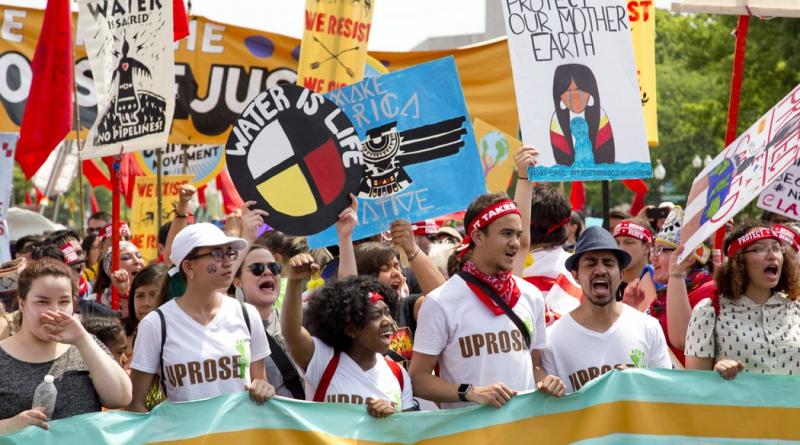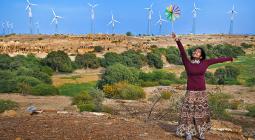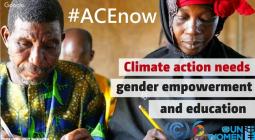Can We Achieve Sustainability While Ignoring Equality?

Pretending environmental protection and economic justice are separate public policy problems will prevent us from ever achieving either.
The Our Common Future report (Brundtland et al., 1987) defines “Sustainable development” as “development that meets the needs of the present without compromising the ability of future generations to meet their own needs.” That seems a reasonable definition. It acknowledges the challenge involves not just our obligations to one another in the present, but also future generations to come.
Sustainability is a challenge that crosses disciplines. It is an economic problem as well as a political one; a scientific challenge as well as a philosophical and moral one (Bruntland et al., 1987) (Jackson, 2009)(Hanna, 2012). As Tim Jackson put it in Prosperity Without Growth (2009), “Capabilities for flourishing are a good starting point from which to define what it means to prosper. But this vision needs to be interpreted carefully: not as a set of disembodied freedoms, but as a range of ‘bounded capabilities’ to live well — within certain clearly defined limits.” (Emphasis added)
Equality will play, as it must, an important role in our society’s efforts to achieve sustainability. This is true whether those efforts are taking place on local, regional, national, or global scales. Either unequal sacrifice that falls disproportionately upon the poor and middle class or unequal distribution of available goods and services that disproportionately favours the wealthy will doom any attempts at sustainable development to eventual failure.
The Necessity of Being In The Same Boat
In his book Collapse (2005), Jared Diamond identifies a key feature common among the failed societies he studied: a conflict of interest between the elite and the masses that leads the elite to act in ways that are contrary to the greater good. In a word, this problem translates as inequality. Diamond writes, “failures to solve perceived problems because of conflicts of interest between the elite and the masses are much less likely in societies where the elite cannot insulate themselves from the consequences of their actions.”
A recognition of Jared Diamond’s point has always been an implicit aspect of the arguments offered by activists working within the environmental justice movement. Graham Haughton (1999) articulates five principles of environmental justice: intergenerational equity, intra-generational equity, geographical equity, procedural equity, and inter-species equity. Addressing the principle of geographical equity specifically, Haughton states, “In a variant of the old saw ‘out of sight, out of mind,’ activities are effectively encouraged when they degrade distant areas, creating uncompensated costs passed on to someone or somewhere else.”
The tension between geographic equity and self-interest can be readily seen in the notion commonly referred to as NIMBYism (not in my backyard). This attitude doesn’t just manifest itself in the form of middle class or wealthy communities demanding that polluting industries and waste disposal sites be located as far from them as possible. It can even interfere with the implementation of clean sustainable projects.
The final nail for the wind farm development known as Cape Wind was driven into the project’s coffin in 2017 when the company proposing it abandoned its rights to the area in Nantucket Sound (Cape Cod Times, 2017). Before the massive 1,500-gigawatt project was ultimately killed, however, it received considerable opposition from wealthy residents of Nantucket, Martha’s Vineyard, and the larger Cape Cod peninsula. These individuals crossed the political spectrum and included the legendary liberal Kennedy family, the conservative Koch brothers, 2004 Democratic presidential nominee John Kerry, and the GOP’s 2012 nominee for president and former Massachusetts governor Mitt Romney (Seelye, 2017).
That projects like Cape Wind would be so openly opposed on the grounds that the wind turbines would negatively impact the view, negatively impact property values, or make it more difficult for boats to navigate through popular sailing waters should give every environmental policymaker pause. The fact that this opposition frequently even came from lawmakers and public figures widely considered friendly to the environmental movement is especially disconcerting.
The case against Cape Wind was unashamedly built around economic and recreational impacts that would only really concern the wealthy. It reveals just how challenging it can be to make progress toward sustainability when even those supposedly on the most receptive end of the political spectrum will so readily choose their own self-interest over a renewable energy project which, if replicated on a large scale, could have significant positive global environmental impacts.
Inequality & Consumption
Richard Wilkinson (2005) argues “Greater inequality is perhaps the most significant obstacle to the development of an environmentally sustainable level of environmental activity.” The reason, according to Wilkinson, is that inequality increases “status competition,” which, in turn, “adds to the pressure to consume as a way of expressing social status.”
If inequality has this kind of negative impact on consumption among lower income families and communities trying to maintain their status in social settings where wealth and its trappings are distributed highly unevenly, great wealth apparently has an even greater impact. This is especially true among the top 10%. A recent Oxfam report (Gore, 2015) found that “The poorest half of the global population are responsible for only around 10% of global emissions” while the wealthiest 10% of the population are “responsible for around 50% of global emissions.”
The disproportionate impact of the wealthiest 10% makes clear that any solution to environmental problems such as greenhouse gas emissions and resource consumption cannot rest upon equally distributing sacrifices across all of humanity. Indeed, it appears that any fair and moral response to our environmental crisis would likely include both some significant improvements in access to resources among the poorest half of humanity while the top 10% simultaneously reduced their consumption dramatically. Even a 50% reduction in consumption by the top 10% and a doubling of consumption by the bottom 50% would result in declines in global consumption of roughly 15% using Oxfam’s (2015) figures provided in the graph above.
However, if Wilkinson (2005) is correct and much of our contemporary consumption, particularly within the world’s most unequal societies, is driven not by need but by a desire to project the appearance of status, it is likely that any overt reduction in consumption among the wealthiest will also reduce the compulsion to consume among the upper middle class and middle class in particular. If this is indeed is the case, global reductions of much greater than 15% could be achieved simply by making equality a policy priority, even as the well-being of the poorest 50% is being dramatically enhanced.
Prioritizing Equality Over Growth
In his book The Upside of Down, Thomas Homer Dixon (2006) argues that most experts advocate for a management response to problems. This, he contends, is usually a mistake. “Any management policies that really address the underlying causes of our hardest problems usually require big changes in the existing economic and political order.” In a consumer culture that places such emphasis on growth, what shape might “changes in the existing economic and political order” take?
In so far as our efforts to achieve sustainability are wed to the equally important goal of maximizing human well-being, two systemic reforms stand out as essential: changing how we measure progress and adopting tax policies that incentivize our efforts to achieve that progress. Currently, growth is our number one political and economic priority, and that growth is measured simply by adding up the total amount of financial resources expended from one year to the next. More money expended this year than last indicates growth. The amount of money spent by any given nation over time is referred to as the gross domestic product (GDP) (van den Bergh, 2009).
Almost from the beginning, however, the GDP has been challenged as an ineffective measurement of progress. “Economics does not offer support for GDP as a measure of social welfare. Quite the contrary,” Jeroen C.J.M. van den Bergh (2009) argues. In fact, “optimal growth theory proposes models that explicitly use a theoretical (usually intertemporal) notion of social welfare that is not identical to a GDP type of criterion.” Bergh goes on to point out that a 2% annual growth rate over a 1000-year period would produce an economy “400 million times the current GDP. It is difficult to imagine that individual or social welfare would increase to such an extent.”
Indeed, a 2% yearly increase in GDP over 1000 years, if achieved, would almost certainly include spending on many things that any individual or society concerned with human well-being and flourishing would repudiate. As Robert Kennedy noted in his 1968 speech at the University of Kansas, “[the] Gross National Product [now known as GDP] counts air pollution and cigarette advertising, and ambulances to clear our highways of carnage. It counts special locks for our doors and the jails for the people who break them. It counts the destruction of the redwood and the loss of our natural wonder to sprawl.”
There are several potential alternatives to the GDP. Jeroen C.J.M. van den Bergh (2009) highlights four leading candidates: the Index of Sustainable Economic Welfare (ISEW), the Genuine Progress Indicator (GPI), the Sustainable Net Benefit Index (SNBI), and the Sustainable National Income (SNI). Space does not allow for a detailed description of these. However, each prioritizes human welfare, natural capital, or some combination of these over the simple increase in economic activity captured by the GDP. As van den Bergh puts it, though each of the alternatives to the GDP he recommends is imperfect, “at the same time, one must recognize that each of the considered alternatives provides a much better approximation of social welfare than GDP.”
With regard to the second systemic reform — changes to tax policy to incentivize the right things — British Columbia stands out as an excellent example of how this might be accomplished. In the summer of 2008, the province of British Columbia implemented North America’s first carbon tax. “There were two prominent features of the BC carbon tax design. First, it was implemented gradually. The tax came into effect on July 1st, 2008. Initially set at $10 per tonne carbon dioxide equivalent (tCO2e), the tax increased by $5/ tCO2e each July 1st until 2012, when it reached its [then] current level of $30/ tCO2e”. The second major feature of BC’s carbon tax was its revenue neutrality. This “meant returning all carbon tax revenues to residents via adjustments to personal and corporate taxes as well as through lump-sum transfers” (Rivers, 2012).
The revenue neutrality of BC’s carbon tax should not be taken to mean those emitting the most carbon necessarily get paid back for all the taxed carbon dioxide they emit. Even a revenue-neutral carbon tax still functions as a tax increase for a significant emitter of CO2. The government hasn’t committed to making sure no one pays more in taxes. Only that all the money generated by the tax gets returned to the public in one way or another.
Under a revenue-neutral carbon tax program, those inclined to use cleaner technologies can reduce their taxes considerably below what others in same tax bracket are paying. A low-income person who decides to purchase a car instead of riding his bike or using mass transit still gets to pocket the quarterly refund payments. But unlike his friends who choose cleaner alternative modes of transportation, his refund payments will go entirely toward offsetting the additional cost of gasoline instead of groceries, rent, or other necessities. In this way, a revenue neutral carbon tax serves two social goods simultaneously: enhancing equality through redistribution of wealth and incentivizing reduced fossil fuel use.
Conclusion
Defending their contention that a new “third generation” approach to sustainability is what’s currently called for, Pamela Robinson and Ann Dale (2012) state that up to now “the discourse has failed to address systemically issues of power and conflict, and class, race, gender, and poverty issues.” As the political and social tensions associated with growing inequality, climate change, and biodiversity loss become more extreme the importance of integrating all these concerns into our efforts to achieve sustainability are becoming that much more urgent.
Activists and politicians alike often treat issues as if they exist in separate silos. Too often movements, businesses, and governments see policymaking in linear zero-sum terms: as though focusing on one problem necessarily draws attention away from another (Kay, 2010). By seeing the multiple social injustices driven by growing inequality and unsustainability as linked rather than competing issues, those concerned with environmental protection could form far stronger and more effective coalitions with the people struggling against poverty, working to strengthen educational opportunities, and fighting to provide greater access to healthcare.
Making equality rather than growth our top priority at both the national and global level will facilitate new connections between movements and interests as well as new social innovations. By adopting tax policies that incentivize sustainable behaviours while simultaneously improving funding for social programs, new initiatives like those broadly outlined within the Green New Deal will be able to build and maintain the public support needed to endure long-term. Furthermore, by curbing excessive consumption at the top feelings of inferiority that often drive consumption among the middle class will also diminish. Taken together, these changes will enable wealthy societies in particular to substantially reduce their ecological footprint while also significantly improving the well-being of the poorest half of their population.
References
Brian Murray, N. R. (2015, August 8). British Columbia’s revenue-neutral carbon tax: A review of the latest “grand experiment” in environmental policy. Energy Policy, 674–683.
Dale, A. (2018). Edging Forward: Achieving Sustainable Community Development. Tatmagouche: Fernweh Press.
Diamond, J. (2005). Collapse: How Societies Choose to Fail or Succeed. New York, New York: Penguin Books.
Gore, T. (2015). Extreme Carbon Inequality. Oxford: Oxfam International. Retrieved from https://www.oxfam.org/en/research/extreme-carbon-inequality
Government of British Columbia. (2018, December). Sustainability. Retrieved March 04, 2019, from Environmental Reporting BC:http://www.env.gov.bc.ca/soe/indicators/sustainability/ghg-emissions.html
Gro Harlem Brundtland, M. K. (1987). Our Common Future. New York.
Haughton, G. (1999, March 1). Environmental Justice and the Sustainable City. Journal of Planning Education and Research, 233–243.
Homer-Dixon, T. (2006). The upside of down: Catastrophe, creativity and the renewal of civilization. Toronto: Knopf.
Jackson, T. (2009). Prosperity Without Growth: Economics for a Finite Planet.London: Earthscan.
Kay, J. (2011). Obliquity: Why our goals are best achieved indirectly. New York, New York: The Penguin Press.
Kennedy, R. F. (1968, March 18). Remarks At the University of Kansas.Retrieved from JFK Library: https://www.jfklibrary.org/learn/about-jfk/the-kennedy-family/robert-f-kennedy/robert-f-kennedy-speeches/remarks-at-the-university-of-kansas-march-18-1968
Kevin Hanna, D. S. (2012). Sustainability and Integrated Approaches to Regional Planning. In W. T. Ann Dale (Ed.), Urban Sustainability: Reconnecting Space and Place (pp. 29–49). Toronto: University of Toronto Press.
Nicholas Rivers, B. S. (2012, August 18). Salience of Carbon Taxes in the Gasoline Market. doi:http://dx.doi.or/10.2139/ssrn.2131468
Pamela Robinson, A. D. (2012). Generational Responses: Why a Third? In W. D. Ann Dale (Ed.), Urban Sustainability: Reconnecting Space and Place (pp. 13–28). Toronto: University of Toronto Press.
Seelye, K. Q. (2017, December 19). After 16 Years, Hopes for Cape Cod Wind Farm Float Away. New York Times. New York, New York. Retrieved fromhttps://www.ack.net/news/20171201/its-over-cape-wind-ends-controversial-wind-farm-project
The Cape Cod Times. (2017, December 1). It’s over: Cape Wind ends controversial wind-farm project. Nantucket, Massachusetts. Retrieved fromhttps://www.ack.net/news/20171201/its-over-cape-wind-ends-controversial-wind-farm-project
van den Bergh, J. C. (2009, January). The GDP Paradox. Journal of Economic Psychology, 30, 117–135. doi:10.1016/j.joep.2008.12.001
Wilkinson, R. G. (2005). The Impact of Inequality: How to make sick societies healthier. London: Routledge.
28 March 2019






